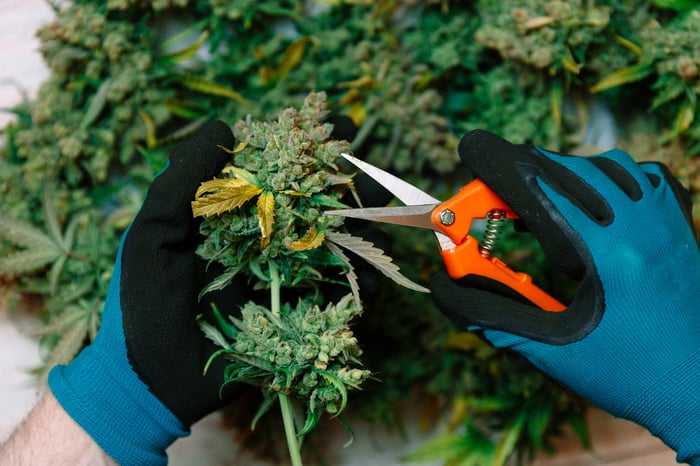Over the long run, the cannabis industry could provide a smorgasbord of growth for investors. Having already tripled global sales between 2014 and 2018, Wall Street has weighed in and expects worldwide weed sales to catapult by another 400% to 1,800% by 2030. The wide margin in Wall Street's forecast reflects the uncertainties associated with launching a high-growth yet still-nascent industry.
Yet at the same time, near-term prospects for the industry aren't as bright. It was long suspected that not every pot stock was going to be a winner, and we've begun to see a shakeout taking place throughout North America.
In particular, financing has become a front-and-center concern, with quite a few marijuana companies scrambling to cut costs and conserve their capital. How are cannabis stocks going to reduce their expenses after a two-year period of frivolous expansion and spending? Here you'll find five ways they'll make it happen.

Image source: Getty Images.
1. Halt construction projects and/or idle cultivation facilities
Beginning last October, we began to see a number of Canadian growers halting construction projects or idling completed projects to not only better align production with consumer demand but also reduce their operating expenses.
The poster child for this is the most popular pot stock, Aurora Cannabis (NYSE:ACB). Aurora announced in November that it would halt construction on Aurora Sun in Alberta and Aurora Nordic 2 in Denmark to save up to a combined $190 million Canadian. It's also putting its 1 million-square-foot Exeter greenhouse up for sale, which was acquired during the MedReleaf acquisition. While these construction halts aren't necessarily permanent, the aggregate loss of peak annual run-rate output from these halts and the Exeter sale is around 430,000 kilos.
Aurora Cannabis' management has made it abundantly clear to its shareholders that positive EBITDA and profitability matter. But at the same time, Aurora has probably lost its spot as Canada's top grower.

Image source: Getty Images.
2. Reduce headcount
Another way cannabis stocks will be looking to reduce expenditures is by laying off workers. With a number of growers cutting back on projects or idling cultivation space, job eliminations are an expected result.
For instance, Quebec-based HEXO (NYSE:HEXO) announced in October that it would be idling cultivation at the 240,000-square-foot Niagara facility (acquired when it purchased Newstrike Brands), as well as halt cultivation for 200,000 square feet of completed space at its flagship Gatineau campus. In addition, HEXO would be eliminating 200 jobs throughout various departments. Until Aurora's very recent announcement that it was eliminating 500 jobs, HEXO's 200 layoffs were the highest in the cannabis industry.
While it is possible that some of these layoffs could prove temporary, they're very much needed in the short run to help push cannabis stocks toward profitability.

Image source: Getty Images.
3. Scale back share-based compensation
A third way pot stocks will be cutting back on expenses is by being more careful with stock-based compensation, which shows up in the expense column on income statements.
For example, former Canopy Growth (NYSE:CGC) co-CEO Bruce Linton believed that offering long-term-vesting stock to employees would be a way to improve loyalty and align their interests with that of the company. In other words, if employees did their job well and everyone executed as planned, their stock would be worth a lot of money down the line. This sounds great on paper, but share-based compensation had grown into Canopy's largest expense by the fiscal second quarter. In fact, share-based compensation topped net sales in Q2 2020.
In Canopy Growth's recently reported fiscal third-quarter results, aggregate share-based compensation was down CA$31 million from the sequential quarter, and it's expected to fall even further. With Constellation Brands' former CFO, David Klein, now at the reins, some serious belt-tightening is in order.

Image source: Getty Images.
4. Make fewer acquisitions
Investors should also expect marijuana stocks to significantly scale back their acquisition activity in 2020. Although buying other businesses can result in cost synergies (i.e., redundant operations are eliminated), it can be financially burdensome for one company to buy another, especially when we're talking about the cash-strapped pot industry.
Aurora Cannabis, for instance, has bet the farm on acquisitions. It's made more than one dozen purchases since August 2016 -- and the huge amount of goodwill on its balance sheet suggests it grossly overpaid for most of those deals. Moving forward, Aurora has to focus on existing revenue-producing assets, and there's little doubt that it'll be shying away from acquisitions.
The same can be said for Canopy Growth. With Canopy's cash, cash equivalents, and marketable securities shrinking from north of CA$4.9 billion to CA$2.27 billion in just one year, the company's management team has made clear that organic opportunities are what they're now focused on.

Image source: Getty Images.
5. Raise capital by issuing stock, rather than taking on debt
Last, but not least, don't be surprised if marijuana companies issue their own stock to raise capital, rather than going the route of issuing convertible debt or taking on traditional secured loans.
The problem is that secured loans in the highly uncertain cannabis industry are going to require repayment within two to four years (most likely). They're also going to accrue interest each year, which further hampers the ability of pot stocks to reduce their expenditures. Issuing stock, while dilutive to existing shareholders, offers a relatively fast way to raise capital.
Not to continually pick on Aurora Cannabis, but no marijuana stock has leaned more on share issuances to raise capital. Over the past 5.5 years, Aurora's share count has ballooned from 16 million shares to 1.17 billion! This share expansion has helped fuel its acquisitive activity, but it's also contributed to the company's share price hitting a three-year low.
"looking" - Google News
February 23, 2020 at 09:06PM
https://ift.tt/38U09gz
5 Ways Cannabis Stocks Are Looking to Cut Costs - Motley Fool
"looking" - Google News
https://ift.tt/2tdCiJt
Shoes Man Tutorial
Pos News Update
Meme Update
Korean Entertainment News
Japan News Update
Bagikan Berita Ini














0 Response to "5 Ways Cannabis Stocks Are Looking to Cut Costs - Motley Fool"
Post a Comment